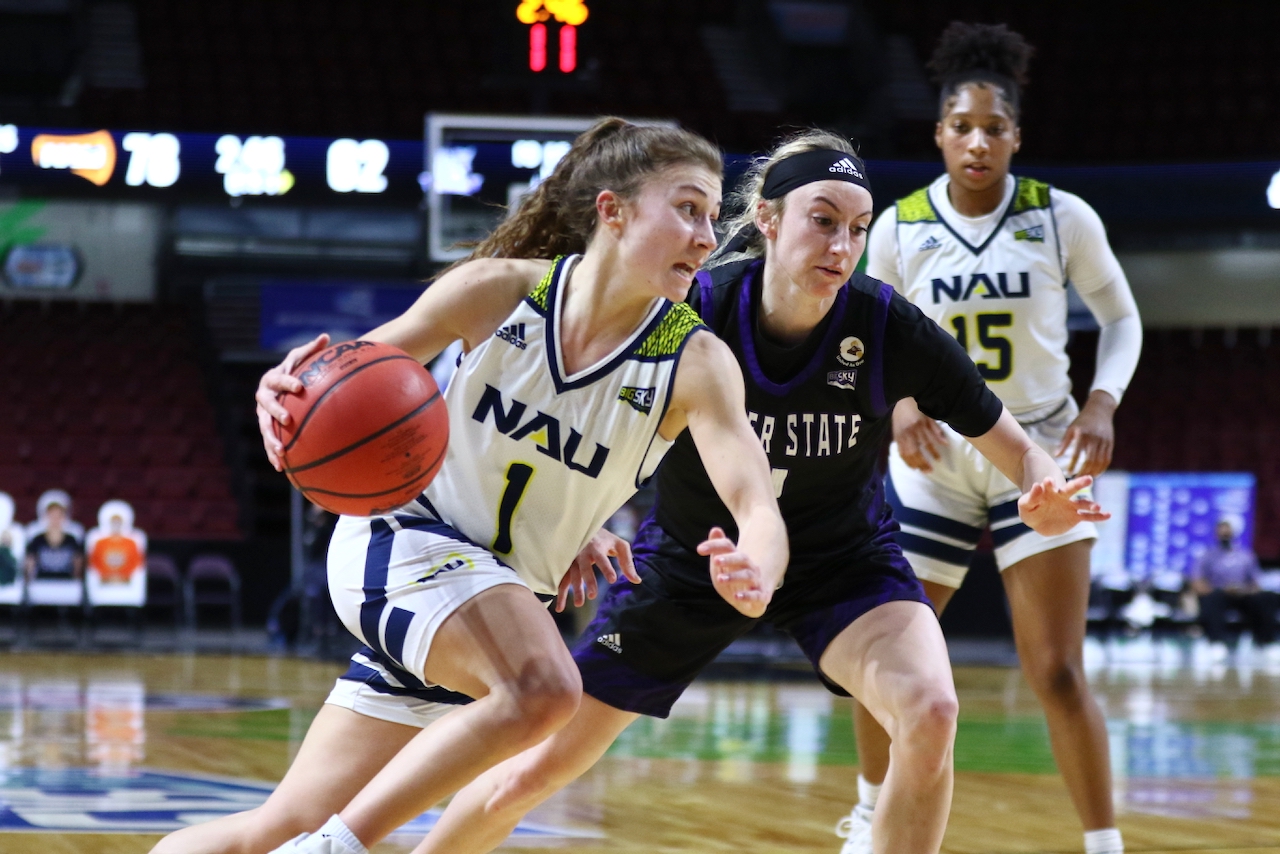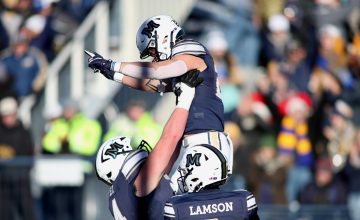BOISE, Idaho — Like a Michelin-starred chef designing the evening’s menu, Loree Payne’s shopping list for a point guard isn’t necessarily long – but the things she wants are non-negotiable.
Payne was a decorated point guard herself, first at Havre High School on the Hi-Line of Montana and then at Washington, where she was a two-time first-team all-Pac 10 selection and set the school record for 3-pointers in a career.
“I’m looking for someone who’s really an extension of our coaching staff, someone with great communication skills, someone with leadership skills that can run a team,” Payne said. “High basketball IQ is really important, because as a point guard you have to make sure that you know your position like everyone else’s position, and how to put your teammates in the best position to score within the system.”
Great point guard play has been a constant of Payne’s grinding six-year journey to take the Lumberjacks to the top of the Big Sky Conference.
In 2017-18, Payne’s first year, former Loyola Marymount transfer Olivia Lucero finished seventh in the conference in scoring with 17.4 points per game and third with 4.6 assists. Two years later, Caitlin Malvar was also third with 4.6 assists per game and an assist to turnover ratio of over 2.0, part of a great class of point guards in the league that year (Gina Marxen, McKenzie Johnston and Kylie Jimenez were also over 2, and lower down on the list were Jessica McDowell-White, Rebecca Cardenas, Oliana Squires, Dora Goles and a young Darian White).
Payne had long had an idea that Regan Schenck might be the next in that line.

“She came from a smaller school up in the Seattle area (Woodinville, Washington), so I’ve been watching her since she was young,” Payne said. “As soon as I got the job down here, I knew she was one that we really wanted to go after.”
Schenck got to Flagstaff just one year after Payne, and just like the program, her rise has been gradual. She sat behind Malvar for a few years as Payne pushed the Lumberjacks back to .500, then narrowly over it.
But now, five years into Schenck’s career, player and program are peaking at the same time. Behind Schenck’s full-send energy and complete control of Payne’s up-tempo style, the Lumberjacks won a share of the regular season conference title for the first time since 1997-98. A year after losing to Montana State in the title game, they’ll enter the conference tournament, which starts Saturday in Boise, as the No. 1 overall seed.
“I knew that she was going to be a potential program changer,” Payne said. “And that was part of the conversation when we were recruiting her. You could come in here and leave a major impact on this program and completely help turn it around, and that’s obviously what she did.”
***
For whatever else she is, Schenck might be the most exhausting player to watch in the league. Always in motion, she bounces on her toes, tensely poised and muscled, radiating nervous energy like a thoroughbred stuck in the starting gate. At 34 minutes per game, if you could make a training DVD of her conditioning routine, it would sell a million copies.
She sprints the ball up the floor even against set defenses, head up, back straight and ponytail swinging, always looking for hit-ahead passes to press the pace even more.
The @ReganSchenck & @nyahmorann duo 🔥🔥#RaiseTheFlag | #BigSkyWBB pic.twitter.com/H1AwSBsIRJ
— NAU Women's Basketball (@NAUWomensHoops) February 25, 2023
“She is definitely their little engine that gets them going,” Idaho State head coach Seton Sobolewski said. “That’s one thing that hurt us in Pocatello was their pace, and she’s the one that drives it. She’s in really good shape, that kid. She’s built, she’s strong. She’s got muscles everywhere. She can just run all day and night.”
That’s exactly the way that Payne wants it. The Lumberjacks play at the fastest pace in the league and one of the 25 fastest in the country, a quantum echo of the Seven Seconds Or Less Phoenix Suns just 150 miles up I-17 in Flagstaff.
NAU had the worst defense in the conference at 72.4 points per game given up…but was equally as far out in front of the field on offense with 75.8 points per game, first in the league by an astronomical margin (Montana, in second place at 70.5 PPG, was much closer to sixth-place Montana State than they were to the Lumberjacks) and still good for a comfortably positive point differential.
“We want to run an up-tempo system, and you have to have players that can get up and down the court to be able to do that,” Payne said. “So she’s been a huge piece to be the catalyst of our offense.”
To complement Schenck, Payne has built a roster around her that fits perfectly into her strengths. The Morans, Olivia and Nyah, are twins from Riverside, California, with a streetball spirit who are always down to run. Emily Rodabaugh and Montana Oltrogge are conscience-less shooters who can flare out to the corners on the fast break or hoist off shoveled kick-back passes in semi-transition (Oltrogge, NAU’s leading scorer, appears to be ready to play in the conference tournament, albeit on reduced minutes, after a scary-looking knee injury suffered against her old team, Idaho State, in early February). Even the starting center, Fatoumata Jaiteh, is one of the most athletic posts in the league, willing and able to run the floor.
In the half-court, Schenck still speeds up the game, skipping passes across the court, bouncing back to the top of the key to reset and then darting into the lane to scramble the defense before tossing wild kickouts back to shooters on the perimeter.
.@ReganSchenck ➕ @nyahmorann 🟰 👌#RaiseTheFlag | #BigSkyWBB pic.twitter.com/e0OQLj8tUB
— NAU Women's Basketball (@NAUWomensHoops) February 28, 2023
Schenck is at the center of it all. For the second time in the last three years, she’s leading the conference in assists, boosting her average from 5.9 per game last year to 6.8.
“Ever since I was young, I always loved the up and down, transition style of basketball,” Schenck said. “It’s really nice having the twins, they’re doing great things out there. Montana is a big guard that can run and all our posts are athletic.”
***
NAU closed the regular season with a flourish, winning four straight and six out of seven to chase down Montana State and end in a tie with the Bobcats and Sacramento State. The Lumberjacks took the No. 1 seed thanks to sweeps over both those teams.
It’s the latest step in an evolution that’s progressed slowly in six years under Payne. Reaching the title game last year was the biggest progress they’ve made so far. This year’s team has a chance to take the path even further.
“I knew when I came in here, I couldn’t have a championship standard immediately with kids who had no idea how to win,” Payne said after losing to Montana State in that game. “So we slowly had to progress and really continue to up the bar, and they continued to fight for it, they continued to work hard.”
Schenck’s own development has been a microcosm of that climb. To reach back for a metaphor, even the best ingredients in the world don’t turn into a gourmet dish on their own. Payne has mentioned that the hardest thing she had to teach the young point guard is how to play slowly. When she arrived five years ago, Schenck had all the tools. What she didn’t have was balance, and feel – the ability to toggle between fast and slow, between looking for own shot or creating for others.
DRAWN UP PERFECTLY 👌@oliviamorann ➡️ @ReganSchenck #RaiseTheFlag | #BigSkyWBB pic.twitter.com/jErKenV3Gl
— NAU Women's Basketball (@NAUWomensHoops) February 17, 2023
This year, she’s in complete control, fully in tune with a team that’s synced up to her own frantic rhythms.
She had 18 points, 13 assists and six rebounds in the season opener against Arizona State; 25, seven and seven as the Lumberjacks came back from down 15 in the fourth quarter at UC Davis (“She just took over, you know, pull up off the ball screen, making defensive plays,” Sobolewski said); 18, 11 and six against Montana State’s DPOY candidate Darian White. After an inexplicable step back in her shooting percentages last year – “I would love to know (what happened),” Payne said deadpan – she’s back above 40% from 3-point range this year on some of the highest volume of her career.
“Last year, we didn’t guard her at the 3-point line, and this year you had to guard her, so that tells you about her work ethic, right?” Montana head coach Brian Holsinger said. “She turned herself into a shooter that you had to guard. … Yeah, geez, I was so impressed. They lose Montana Oltrogge and they still continue to win, that’s not easy. And she’s getting assists, she rebounds. She just does so much.”
Northern Arizona opens the Big Sky tournament on Sunday at noon against the winner of Saturday’s game between No. 9 Northern Colorado and No. 10 Weber State.














